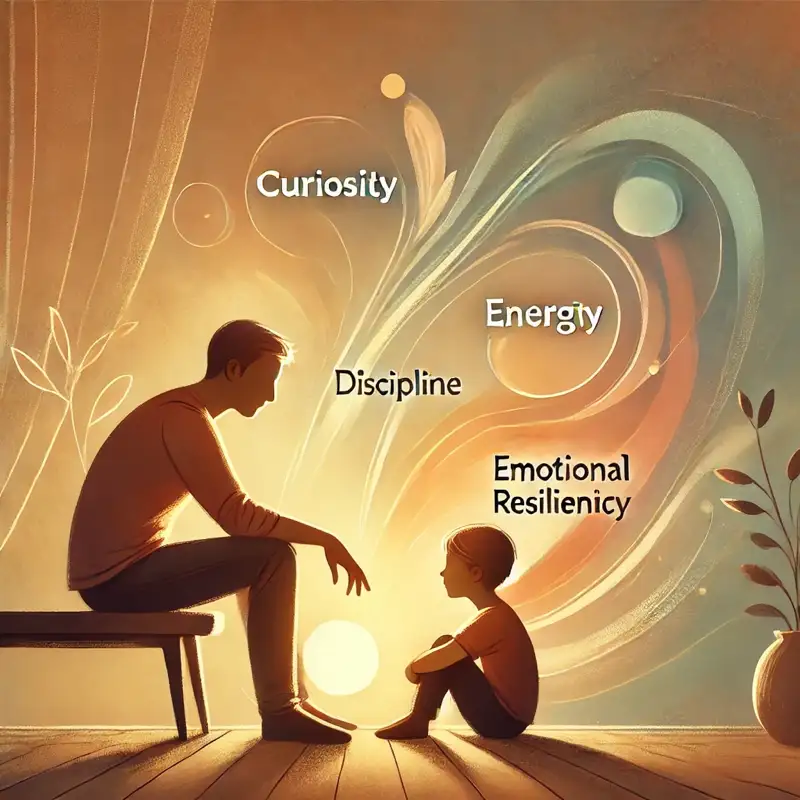
Support Your Child’s Mental Well-Being
4 min read
Using the Big Five Personality Test to Support Your Child’s Mental Well-Being
Parenting is one of life’s greatest challenges—and rewards. Every child is unique, with their own way of thinking, feeling, and reacting to the world. But what if you had a scientific tool to better understand your child’s personality and how to support their mental resilience? The Big Five Personality Test can help parents gain valuable insights into their child’s strengths, challenges, and emotional needs.
This article explores how parents can use the Big Five model to foster mental well-being in their children and provides a simple evening activity to make it both fun and meaningful.
Why Personality Awareness Matters for Mental Health
Mental resilience isn’t just about avoiding stress or anxiety—it’s about understanding emotions, managing challenges, and developing self-awareness. The Big Five Personality Model measures five key traits:
- Openness to Experience – Creativity, curiosity, and love for new ideas.
- Conscientiousness – Organization, responsibility, and self-discipline.
- Extraversion – Sociability, energy, and preference for social interaction.
- Agreeableness – Empathy, kindness, and cooperation.
- Neuroticism – Emotional sensitivity, stress levels, and mood stability.
By understanding where a child falls on these traits, parents can adapt their support strategies to help them thrive.
An Evening Activity: Understanding Each Other Through the Big Five
Step 1: Setting the Scene
Choose a calm, relaxed evening when everyone has time to talk. Prepare some snacks, dim the lights, and make it a cozy environment. Emphasize that there are no right or wrong personalities—only different ways of thinking and feeling.
Step 2: Taking the Test
Let each family member (including the parents!) take a free Big Five personality test. If your child is younger than 12, consider answering the questions together and explaining them in simple terms. If your child is a teenager, allow them to answer privately but encourage discussion afterward.
Step 3: Reflecting on the Results
Once everyone has their scores, discuss the results with curiosity. Ask questions like:
- Did anything surprise you?
- Do you feel your results describe you accurately?
- What are some strengths you see in yourself based on your personality?
Make it a safe and positive conversation—this is about understanding, not judgment.
How Parents Can Use the Results to Support Their Child
Openness to Experience:
- High Openness: Encourage creative hobbies (art, music, books), allow space for curiosity, and expose them to diverse experiences.
- Low Openness: Provide structured learning, ease them into new things slowly, and help them feel comfortable with change.
- Example: A 15-year-old girl high in Openness may love deep conversations and abstract thinking, while a 10-year-old boy low in Openness may prefer practical, hands-on learning.
Conscientiousness:
- High Conscientiousness: These children thrive on routines, responsibility, and goal-setting—support their need for structure.
- Low Conscientiousness: Help them develop small, manageable habits rather than overwhelming tasks.
- Example: A teenage boy low in Conscientiousness may struggle with deadlines, so breaking tasks into small steps can help.
Extraversion
*High Extraversion: These children love social activities—encourage friendships, teamwork, and interactive learning. Low Extraversion: Respect their need for alone time and avoid forcing them into too many social situations. Example: A 10-year-old introverted child might need breaks after social events, while a teen extrovert might struggle with loneliness if isolated.
Agreeableness
- High Agreeableness: Support their empathy but help them set boundaries—being too agreeable can lead to people-pleasing.
- Low Agreeableness: Teach them to consider others’ feelings and practice patience in social situations.
- Example: A kind and agreeable child may need guidance on standing up for themselves in conflicts.
Neuroticism
- High Neuroticism: Teach emotional regulation techniques, encourage self-reflection, and provide reassurance without overprotecting.
- Low Neuroticism: These children are naturally resilient—help them understand that others may feel emotions more deeply.
- Example: A teen girl high in Neuroticism might experience more anxiety about friendships, while a boy with low Neuroticism may struggle to understand why others feel upset.
Key Takeaways for Parents
- Personality is not destiny. While traits are stable over time, habits, environment, and support shape a child’s growth.
- Balance is key. Each trait has strengths and challenges—help your child use their strengths while managing their struggles.
- Self-awareness builds resilience. When children understand their personality, they learn self-acceptance and emotional intelligence.
Final Thought: Parenting isn’t about changing who your child is—it’s about understanding them deeply so you can give them the best foundation for life.
So, here’s a question for you as a parent: How well do you really know your child’s personality, and how can you support them in becoming the best version of themselves?